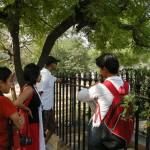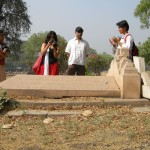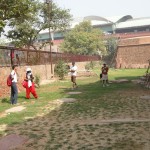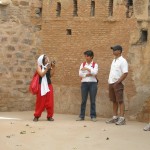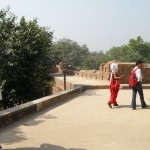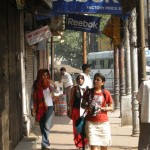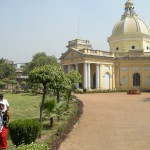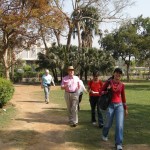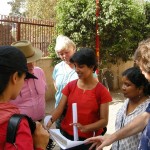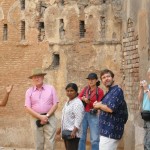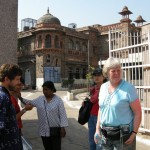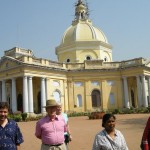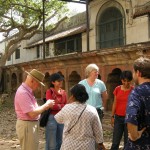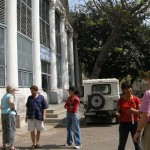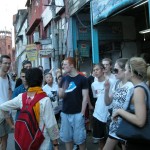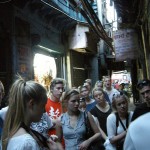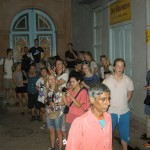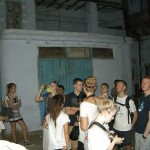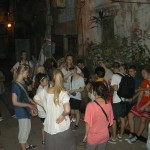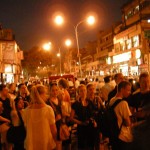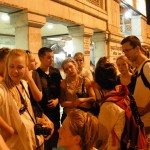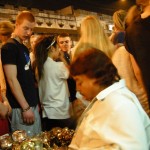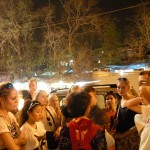Posts Tagged ‘Shahjahanabad’
May 24, 2010 in 1857,Delhi Heritage Walks,DHW,Heritage Walks,Kashmiri Gate,Kashmiri Gate Heritage Walks | Comments (0)
Braving the summer heat, a group of heritage enthusiasts got together to explore the landmarks of the revolt of 1857 in Delhi. We covered sites located in the neighbourhood of Kashmiri Gate which falls within the old city, the former Mughal capital of Shahjahanabad. The starting point was Nicholson’s cemetery, named after Brigadier General John Nicholson who died fighting the rebels in 1857. He was fatally shot during the storming of Lahori gate, during recapture of Delhi by the British in September 1857. Another important person who is buried here is Master Ramachandra, professor of Mathematics in the then Delhi College. Across the road from Nicholson’s cemetery are remains of the city walls and the Kashmiri gate. The road roughly marks the demarcation between rebels inside the city and where the British were camped on the Ridge. The Kashmiri gate is one of the four surviving gates of the boundary of Shahjahanabad. The others which still stand are Ajmeri gate, Turkman gate & Dilli gate. Kashmiri gate still bears the damaged done to it by the British cannons while storming the city. There is also a memorial to the dead of the British army at this gate. Continue Reading This Post
April 27, 2010 in 1857,Delhi Heritage Walks,DHW,Heritage Walks,Kashmiri Gate,Kashmiri Gate Heritage Walks | Comments (1)
This heritage walk covers the modern neighbourhood of Kashmiri Gate near the ISBT. Most of the sites here relate to first half of 18th century and some specific events associated with the revolt of 1857. In the 17th century this area was part of the Mughal capital of Shahjahanabad, what is today old Delhi. Kashmiri gate has mansions of some important personalities associated with the Mughal court like, Ali Mardan Khan, the noble who was instrumental in building canals which brought water to the city and Dara Shukoh, Shahjahan’s son. Later, the British started living in this neighbourhood. It is their buildings which mostly survive now.
We started the heritage walk from Nicholson’s cemetery. John Nicholson was a British general, instrumental in breaching the defenses of rebels who were controlling Delhi, and in the process lost his life. The cemetery is named after him, but there are other important people buried here as well. Continue Reading This Post
March 16, 2010 in Chandni Chowk,Chandni Chowk Heritage Walks,Delhi Heritage Walks,DHW,Heritage Walks,Old Delhi | Comments (0)
A group of students from Denmark on their first trip to India joined us for a heritage walk in old Delhi on Sunday evening. The old city of Delhi is the capital built by the Mughal emperor Shahjahan, who named the new capital after himself, Shahjahanabad. The Red Fort was his palace-fort complex and Jama Masjid the congregation mosque of the city.
We wandered through the narrow lanes of old Delhi: looking at the haveli facades in Katra Khushal Rai, the Digamber Jain Naya Mandir, Naughara, Parathewali Gali. The havelis and Jain temples in the city have a typical late-Mughal aesthetic style: the arches, the life-like representation of flowers, etc, patronised by Shahjahan and used extensively after him. Naughara is a group of havelis (mansions) which still retain much of their traditional appearance.
Next on the route was the main street of Chandni Chowk, Continue Reading This Post
January 4, 2010 in Chandni Chowk,Delhi Heritage Walks,DHW,Heritage Walks,Old Delhi,Old Delhi Heritage walks | Comments (0)
The advantage of starting early was that the Red Fort complex was not crowded. Otherwise on holidays and in evenings one always sees a huge rush…this is a prime tourist destination after all. One enters from the Lahori gate. The shops in Chhatta Chowk weren’t open yet. There are some beautiful murals in the music gallery (Naubat Khana), unfortunately, they are badly deteriorated. One can see the different layers of paint on the wall done over several years. The Naubat Khana now has the Indian War Memorial Museum. The Diwan i Aam or Hall of public audience was our next stop. It is an extremely elegant sandstone building. This is the place where Shahjahan held court daily. The marble throne canopy with its delicate inlay work is awesome! The riverside pavilions are few of the private palaces of the royal family that still exist. The Mughal buildings we see in Red Fort today are only about 20% of all that existed originally. Continue Reading This Post
« Newer Posts Older Posts »
